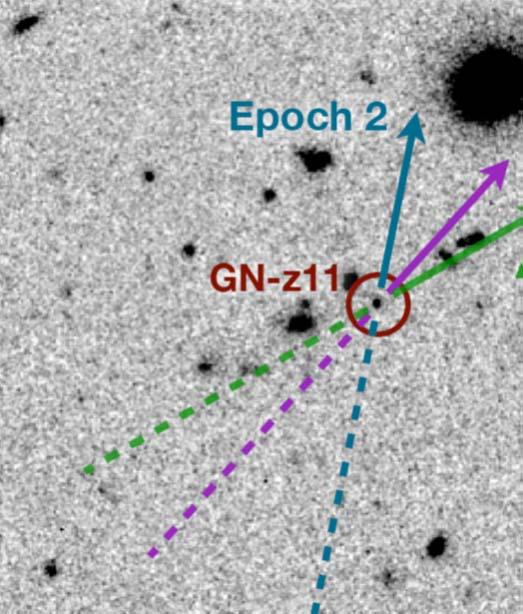
A near-infrared image of the sky showing the source GN-z11 (in the circle), the farthest known galaxy with a spectroscopically confirmed distance; it dates from a time a mere 400 million years after the big bang. (The lines show details of the spectrometer orientation.)
The epoch when the very first stars appeared in the universe is unknown but is of tremendous interest. These stars began the manufacturing of the chemical elements (heavier than hydrogen and helium), the reionization of the neutral cosmic gas, and mark the dawn of the universe as we know it today. Astronomers estimate that they appeared roughly a few hundred million years after the big bang and soon, as their host galaxies matured, their activity dominated the complex evolution of the cosmos. Thousands of candidates for these early galaxies have been spotted so far despite their being distant and faint. Many were discovered at far infrared or submillimeter wavelengths because they are making stars at fantastic rates (over a thousand per year) and are correspondingly luminous in infrared bands.
Identifying a faint galaxy as being from this early epoch requires measuring its distance, that is its redshift, the amount its light has shifted to the red due to the expansion of the universe (Hubble discovered that the redshift was proportional to the distance). The most reliable redshifts are determined from spectroscopic measurements of known atomic lines, but because distant galaxies are so faint the more common method is to estimate the redshift from their overall color. There are currently about 800 known galaxies whose redshifts using this latter method place them in the epoch around six-to-eight hundred million years after the big bang. The most distant known galaxy with a firm spectroscopic redshift is also from this period, about 580 million years after the big bang.
CfA astronomers Matt Ashby, Giovanni Fazio, and Steve Willner and their colleagues used the Hubble Space Telescope and the IRAC camera on Spitzer to make a spectroscopic discovery of the most distant galaxy known, dating from an epoch around 400 million years after the big bang – about 150 million years earlier than the previous record-holder. If the first stars did indeed appear a few hundred millions years earlier than this time, then this new galaxy only took as long to descend from those first galaxies as we took to succeed the dinosaurs. The galaxy is known only as GN-z11, from the GOODS-North project (a sky survey which took very sensitive infrared images), and the numerical value of its redshift (z=11.1). The success of the measurement was possible because of the considerable luminosity of this galaxy, the result of star formation at a rate of about twenty stars per year. As for the bulk of the galaxy's stars, their aggregate color suggests that most of them are only about forty million years old. The implications of this dramatic new discovery is that the models are in reasonable shape, that massive galaxies formed quite early in cosmic times, and that upcoming, sensitive space missions should easily be able to discover many more of them.
"A Remarkably Luminous Galaxy at z=11.1 Measured with Hubble Space Telescope Grism Spectroscopy," P. A. Oesc, G. Brammer, P. G. van Dokkum, G. D. Illingworth, R. J. Bouwens, I. Labbe, M. Franx, I., Momcheva, M. L. N. Ashby, G. G. Fazio, V. Gonzalez, B. Holden, D. Magee, R. E. Skelton, R. Smit, L. R. Spitler, M. Trenti1, S. P. Willner, ApJ 2016 (in press)
Related News
CfA Scientists Play Important Role in New NASA Mission
Runaway Stars Reveal Hidden Black Hole In Milky Way’s Nearest Neighbor
CfA Celebrates 25 Years with the Chandra X-ray Observatory
CfA Astronomers Help Find Most Distant Galaxy Using James Webb Space Telescope
Unexpectedly Massive Black Holes Dominate Small Galaxies in the Distant Universe
Distant Stars Spotted for the First Time in the Vast Magellanic Stream
CfA Scientists Help Reach New Milestone in Quest for Distant Galaxies
Astrophysicists Hunt for Second-Closest Supermassive Black Hole
The Tilt in our Stars: The Shape of the Milky Way's Halo of Stars is Realized
JWST Draws Back Curtain on Universe's Early Galaxies
Projects
2MASS Redshift Survey
AstroAI
Dark Energy Spectroscopic Instrument (DESI)
GMACS
For Scientists